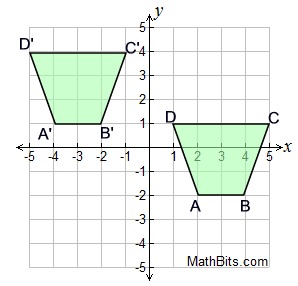Transformations (Translation, Reflection & Rotation)
Translation
Translation
Question 1
Which term best describes a translation?
Question 2
Translate the original triangle ABC 3 units to the left and 2 units up. What are the new coordinate points of Triangle A'B'C'? Hint: Make sure the triangles are exactly on top of each other before performing the translation.
Question 3
Translate the original triangle ABC 3 units to the left and 2 units up. What are the new coordinate points of Triangle A'B'C'? Hint: Make sure the triangles are exactly on top of each other before performing the translation.
Question 4
What happens to x coordinate value when you translate the figure to the left? What about when you translate the figure to the right?
Question 5
What happens to y coordinate value when you translate the figure down? What about when you translate the figure up?
Question 6
For the given figures ABCD and A'B'C'D', Describe how the pre-image is translated to the new image? Are the two figures congruent?

Reflection
Reflection
Question 1
Which term best describes a reflection?
Question 2
Rearrange the triangle so point A is at (4, 2). What is the point of reflection over the y-axis for point A? Now translate point A, 2 units up. What is the new point of reflection for over the y-axis for point A?
Question 3
Relating to question 1, what difference do you notice about the coordinate points before and after the reflection over the y-axis?
Question 4
Rearrange the triangle so point B is at (5, 1). What is the point of reflection over the x-axis for point B? Now translate point B, 3 units to the right. What is the new point of reflection for over the y-axis for point B?
Question 5
Relating to question 3, what difference do you notice about the coordinate points before and after the reflection over the x-axis?
Question 6
Which formula below best illustrates a reflection over the y-axis?
Question 7
Which formula below best illustrates a reflection over the x-axis?
Question 8
Reflect the points below over the x-axis. What the new coordinate points A', B' and C'? A (1, 3) B (3, 4) C (-2, 5)
Question 9
Reflect the points below over the y-axis. What the new coordinate points A', B' and C'? A (5, 2) B (1, 6) C (3, -7)
Question 10
A reflection over the x-axis makes the ________ opposite.
Question 11
A reflection over the y-axis makes the ________ opposite.
Rotation
Rotation
Question 1
Which term best describes a rotation?
Question 2
A copy of a figure is called ________.
Question 3
Rigid transformations (translation, reflection, rotation) produce __________ figures.
Question 4
Rearrange the triangle so point A is at (5, 7), point B is at (9, 6) and point C is at (4, 3). What are the new coordinate points of A', B' and C' after a 90 degree clockwise rotation? What pattern you notice between the original points and the rotated points?
Question 5
Rearrange the triangle so point A is at (5, 7), point B is at (9, 6) and point C is at (4, 3). What are the new coordinate points of A', B' and C' after a 180 degree rotation? What pattern you notice between the original points and the rotated points?
Question 6
To rotate a figure 90 degrees clockwise, use this representation:
Question 7
To rotate a figure 180 degrees, use this representation:
Question 8
Rotate the points below 90 degrees clockwise about the origin. What the new coordinate points A', B' and C'? A (4, 4) B (2, -1) C (-2, 3)
Question 9
Rotate the points below 180 degrees about the origin. What the new coordinate points A', B' and C'? A (-2, 3) B (4, -1) C (-5, -2)